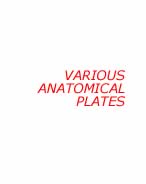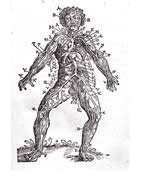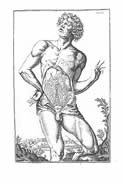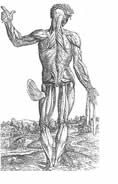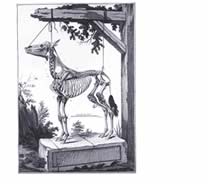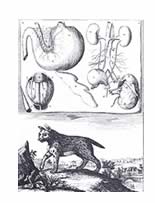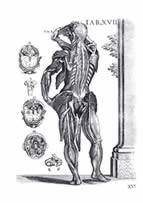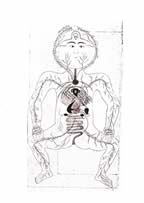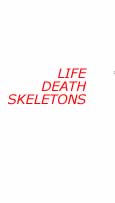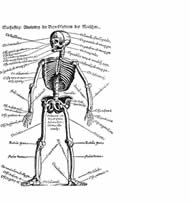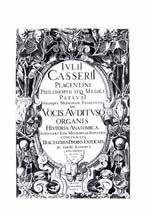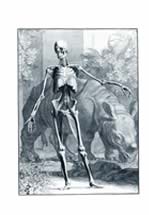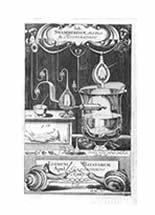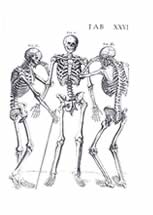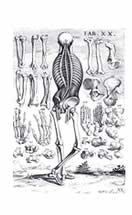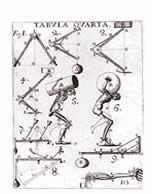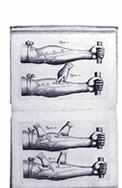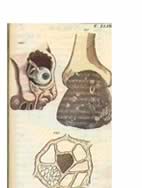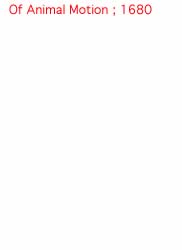.....................................................................
A MISCELLANY OF
ANATOMICAL PLATES
01 Paracelsus, Aureolus Phillipus Theophrastus, Erster Theyl der
Grossen Wundartzeney.. .Frankfurt 1563, and a book prodigiously
illustrated with woodcuts. The illustration uses a mode of identification
with references to a separate chart. The overall impression is one of
an ungainly body and suppressed pain.
09 An Islamic manuscript, Anatomy of Mansur , Iran, 16th
century, having been composed in 1396. It is written in Nasta'liq script
and has six sections, each with an illustration -
Skeletal System - Nervous System - Muscular System - Venous System - Arterial
System - and the Arterial System of a Pregnant Woman. Catalogued
and reproduced in Maggs Brothers Sale catalogue " The Art of Writing
", London undated (c1935) p.385.
06 BUFFERIN advert August 1955 12 x 15cms
03, 04 Two examples of illustration from anatomy books; left Spigelius, Opera quae extant omnia , Blaue, Amsterdam, 1645 done
when the author was Professor of Anatomy at Padua, the plates deriving
from Casserius' unpublished Theatrum anatomicum.
from a 1555 edition of Andreas Vesalius' De humani corporis fabrica libri
septem, published by Johannes Oporinus in Basle.
two plates from Charles Estienne, La Dissection des parties du corps humain
diusee en trois liures. .. de Colines, Paris, 1546. The woodcuts of figures
are said to have been drawn by G.B.Rosso, from life (or rather death)
in an Italian cemetery. Rosso makes the female figures particularly sensuous
and yearning, even in their exposed condition.
from Pietro da Cortona's Tabulae Anatomicae .... published
in Rome in 1741.
Claude Perrault, Memoirs for a Natural History of Animals , Streater, London 1688.
05 Philippe Etienne La Fosse, Cours Hippiatrique... Edme
Paris 1772. The celebrated book dedicated to all aspects of the Horse.
This is an inventive combination of objective drawing and the Scenic.
LIFE
DEATH SKELETONS
Albinus
(Bernhardus Siegfried) Tabulae Sceleti et Musculorum Corporis
Humani, Verbeek at Leiden 1747, and the most celebrated of anatomic
atlases, much beloved for its attempts to wed the unreal world of the
anatomical specimen with the landscape perceived by us all - aggregating
to an intensified surreal vision of a dream world - an umbrella encountering
a sewing machine on an operating table. The twenty eight engraved plates
are executed by Jan Wandelaar, here incorporating the famous rhino that
was acquired by Amsterdam Zoo in 1741, the first of its kind in Europe.
from Hans von Gersdorff's Feldbuch der Wundartzney
, Strassbourg, 1540, and a diagrammatic representation of the
human skeleton. Given the convention of line that directs the eye and
the need to compress text - this is an interesting solution. There is
a difficulty where the information between the legs begins to suffer from
crowding. Note the uneasy suggestion of a platform upon which the skeleton
stands, and the predominance of the diagrammatic.
Two plates
from Pietro da Cortona's Tabulae Anatomicae .... published
in Rome in 1741.
From William
Chiselden, Osteographia or The Anatomy of the Bones ,
printed by William Bowyer in 1733.
02 Titlepage
to Julius Casserius, De Vocis Auditusque Organis Historia Anatomica , Baldinus at Ferrara, 1600 - 1601. "A Masterpiece of Book
Illustration and the most beautiful book ever published on the ear and
throat..." The illustrations are in copperplate engraving and are
thought to be by the German artist, Joseph Maurer. The titlepage is in
many ways a contrast to the anatomical accuracy achieved within the book
- a fantastic assemblage of little boney folk in the exact poses struck
by posturing emblematic figures on a conventional seventeenth century
titlepage.
04 Titlepage to Jan Swammerdam's Tractatus Physico-Anatomico-Medicus
de Respiratione Usque Pulmonum , Leiden 1667. The association
of the snails bearing down on the date is a marvellous conceit.
OF
ANIMAL MOTION
Two plates
from Giovanni Borelli, De Motu Animalium , Of Animal
Motion; 1680, engraving of various stages of muscles expanding and contracting
in human and animal forms.
BODY
PARTS
01 from
William Hervey's De Motu Cordis & sanguinis in animalibus,
anatomica exercitatio, Leiden 1639.
02 from a German Medical Book, c1810 with handcoloured plates providing
a populist guide to the body, physiognomy, and general pharmacy; each
page measures 10 x 17cms.
 ANDREAS VESALIUS, Figures and fragments ANDREAS VESALIUS, Figures and fragments
 The World of Wonder 1932, the senses The World of Wonder 1932, the senses
.............. |





